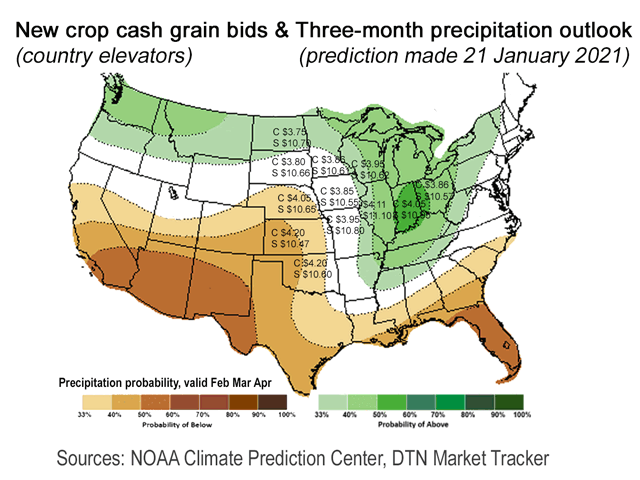Kub's Den
It Always Rains After a Dry Spell
This is ostensibly not the time of year when weather matters much to a North American grain farmer. The Earth is either shivering while the west wind rushes across its bare landscape or slumbering under a thick white comforter of snow. Neither scenario supports seeds to start growing, and when the seeds aren't even growing, the farmers (and the grain traders and everyone else in the market) can't really get too worked up about the weather. We either feel fortunate for having a mild winter with easy driving conditions (and grain-hauling conditions and cattle feeding conditions), or we shrug and shovel snow that is, admittedly, rather lovely to have around sometimes.
About that snow ...
A nice helping of snow fell this week directly over the central Corn Belt, with a pocket of Nebraska receiving more than a foot of coverage. That may sound like a lot, but it's no drought buster. Lincoln, Nebraska, (coincidentally the home of the U.S. Drought Monitor map-making office) has been lingering in D1 Moderate Drought, and although they have a new 14 inches of fluffy snow to shovel -- that amount is only equivalent to about one inch of rain.
The drought remains.
Recall that this drought, which reigns across a huge portion of the United States' western corn-growing acres, has been lingering since the end of last summer. From western Iowa, to Minnesota, to the Dakotas, across all of Nebraska (even the non-irrigated bits), and deep into western Kansas and Colorado where it's deteriorated into D3 Extreme Drought. Last summer in the heart of the Corn Belt, southwest Iowa experienced its driest August on record, and Illinois statewide experienced its 13th driest August on record. There is still a lot of moisture that has yet to be made up.
P[L1] D[0x0] M[300x250] OOP[F] ADUNIT[] T[]
Perhaps this isn't the season when day-to-day North American weather affects the markets much, but this drought scenario still matters, because this is very much the typical season for new-crop grain hedging. Grain producers are flipping through seed catalogs, evaluating their upcoming equipment needs and sitting down with their lenders to pencil out cash flow projections. Seeing $4 per bushel offered by their local elevator for new-crop corn or $10.60 per bushel for new-crop soybeans, and knowing how rare and fleeting such profitable opportunities have been in recent years, it is surely tempting to lock in that price for all the bushels an operation expects to produce in 2021.
The continuous soybean futures chart has rallied 60% since the start of the August dryness (and Chinese buying spree), going from $9 per bushel to $14.38 1/4 at the peak on Jan. 13. But, meanwhile, the late 2021 futures contracts, which represent the upcoming U.S. crop, haven't fully participated in that exuberant rally. On days when the nearby futures jump 20 cents, the new-crop futures might only shift 10 cents. The November 2021 soybean futures contract also started at $9 last August, but only made it as high as $12.03 so far this month. The December 2021 corn futures contract only traded as high as $4.65 1/2 and has pulled back since that achievement. So, when grain producers look to their local country elevators to lock in prices on forward contracted new-crop bushels, they'll see attractive opportunities but not mind-blowing, history-making, extreme-profit opportunities. Today's milder opportunities are easier to ignore.
Every year, we tend to collectively succumb to the fear that we shouldn't sell too much in the spring, because, oh-no, what if there's a crop failure and we've sold more than we can produce and we have to buy out of contracts at inflated prices etcetera, etcetera, etcetera. Regret is the typical result, when we end up selling the grain at harvest or later, receiving lower prices than were originally offered at the start of the marketing season.
But this year more than most years, we can all recognize that, for grain producers in certain regions, the fear of poor 2021 yields may be extremely valid. The National Weather Service's Climate Prediction Center expects La Nina "to continue through the Northern Hemisphere winter 2020-21 (95% chance during January-March), with a potential transition to ENSO-neutral during the spring 2021 (55% chance during April-June)." I conferred with DTN Senior Ag Meteorologist Bryce Anderson about this, and while he cautions "there are a lot of moving parts ahead" and "La Nina scenarios are highly variable," he is also watching a meteorological model that suggests it may even strengthen through the spring and summer. "I'm quite concerned about how the total 2021 season is going to run. Having confidence for nationwide trendline yield is questionable," Anderson said.
Note that he flagged "nationwide" yields, but not Eastern Corn Belt yields, where farmers are not only less plagued by ongoing drought already, they are also favored by long-term weather forecasts that expect a probability of above-average precipitation through the next three months. And if the Eastern Corn Belt experiences a favorable growing season, Anderson points out that, "2012 won't be an accurate comparison because it was bone dry everywhere that year versus the 2021 scenario where it could be the haves and have-nots of the Eastern Corn Belt and the Western Corn Belt."
Ultimately, all weather is local, and all grain marketing decisions are too. Individual producers can factor in the broad and variable potential weather scenarios for their own locations and consider how much local yield uncertainty is reasonable to weigh against the profitable new-crop opportunities offered everywhere.
Elaine Kub is the author of "Mastering the Grain Markets: How Profits Are Really Made" and can be reached at masteringthegrainmarkets@gmail.com or on Twitter @elainekub.
(c) Copyright 2021 DTN, LLC. All rights reserved.



